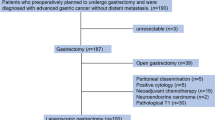Abstract
Purpose
Our previous study demonstrated that a transcription reverse-transcription concerted (TRC) diagnosis using peritoneal lavage fluids at laparotomy was a potential prognostic factor for gastric cancer patients; however, the clinical importance of a TRC diagnosis from peritoneal lavage fluids after lymphadenectomy remains unclear.
Methods
TRC amplification targeting CEA mRNA was utilized to detect free cancer cells before and after lymphadenectomy during gastric cancer resection. Of 120 patients who underwent curative gastrectomy for cT2-T4 gastric cancer, 38 whose peritoneal lavage samples were collected pre- and post-lymphadenectomy were eligible for analysis.
Results
Six (16.0 %) patients had CEA positivity before lymphadenectomy (pre-CEA), whereas nine (23.7 %) had CEA positivity after lymphadenectomy (post-CEA). Post-CEA was significantly correlated with higher pathological N-stage. Moreover, the positive post-CEA group had significantly worse relapse-free survival than the negative post-CEA group (p = 0.001). Cox multivariate analysis revealed that post-CEA positivity was a significant predictor of poor relapse-free survival (p = 0.012). It was also a predictor of distant metastasis, but not specific for peritoneal recurrence.
Conclusions
These findings demonstrated that post-CEA positivity in a TRC diagnosis was a potential predictor of disease recurrence, but not a specific predictor of peritoneal recurrence.

Similar content being viewed by others
Abbreviations
- TRC:
-
Transcription reverse-transcription concerted reaction
- CEA:
-
Carcinoembryonic antigen
References
Sasako M, Sakuramoto S, Katai H, et al. Five-year outcomes of a randomized phase III trial comparing adjuvant chemotherapy with S-1 versus surgery alone in stage II or III gastric cancer. J Clin Oncol. 2011;29:4387–93.
Sakuramoto S, Sasako M, Yamaguchi T, et al. Adjuvant chemotherapy for gastric cancer with S-1, an oral fluoropyrimidine. N Engl J Med. 2007;357:1810–20.
Aoyama T, Yoshikawa T, Hayashi T, et al. Risk factors for peritoneal recurrence in stage II/III gastric cancer patients who received S-1 adjuvant chemotherapy after D2 gastrectomy. Ann Surg Oncol. 2012;19:1568–74.
Imano M, Okuno K. Treatment strategies for gastric cancer patients with peritoneal metastasis. Surg Today. 2014;44:399–404.
Emoto S, Sunami E, Yamaguchi H, Ishihara S, Kitayama J, Watanabe T. Drug development for intraperitoneal chemotherapy against peritoneal carcinomatosis from gastrointestinal cancer. Surg Today. 2014;44:2209–20.
Sun Z, Xu YY, Wang ZN, et al. Macroscopic serosal classification predicts peritoneal recurrence for patients with gastric cancer underwent potentially curative surgery. Ann Surg Oncol. 2011;18:1068–108.
Association JGC. Japanese classification of gastric carcinoma. 3rd English edition. Gastric Cancer. 2011;14:101–12.
Nakajima T, Harashima S, Hirata M, et al. Prognostic and therapeutic values of peritoneal cytology in gastric cancer. Acta Cytol. 1978;22(225–22):9.
Abe S, Yoshimura H, Tabara H, et al. Curative resection of gastric cancer: limitation of peritoneal lavage cytology in predicting the outcome. J Surg Oncol. 1995;59(226–22):9.
Funami Y, Tokumoto N, Miyauchi H, et al. Prognostic value of peritoneal lavage cytology and chemotherapy during surgery for advanced gastric cancer. Int Surg. 1999;84(220–22):4.
Suzuki O, Fukuchi M, Mochiki E, et al. Prognostic role of gastrectomy in patients with gastric cancer with positive peritoneal cytology. Int Surg. 2014;99(830–83):4.
Koga S, Kaibara N, Iitsuka Y, et al. Prognostic significance of intraperitoneal free cancer cells in gastric cancer patients. J Cancer Res Clin Oncol. 1984;108(236–23):8.
Bonenkamp JJ, Songun I, Hermans J, et al. Prognostic value of positive cytology findings from abdominal washings in patients with gastric cancer. Br J Surg. 1996;83(672–67):4.
Bando E, Yonemura Y, Takeshita Y, et al. Intraoperative lavage for cytological examination in 1,297 patients with gastric carcinoma. Am J Surg. 1999;178:256–62.
Nakanishi H, Kodera Y, Yamamura Y, et al. Rapid quantitative detection of carcinoembryonic antigen-expressing free tumor cells in the peritoneal cavity of gastric-cancer patients with real-time RT-PCR on the lightcycler. Int J Cancer. 2000;89(411–41):7.
Sugita Y, Fujiwara Y, Taniguchi H, et al. Quantitative molecular diagnosis of peritoneal lavage fluid for prediction of peritoneal recurrence in gastric cancer. Int J Oncol. 2003;23(1419–142):3.
Fujiwara Y, Doki Y, Taniguchi H, et al. Genetic detection of free cancer cells in the peritoneal cavity of the patient with gastric cancer: present status and future perspectives. Gastric Cancer. 2007;10(197–20):4.
Fujiwara Y, Okada K, Hanada H, et al. The clinical importance of a transcription reverse-transcription concerted (TRC) diagnosis using peritoneal lavage fluids in gastric cancer with clinical serosal invasion: a prospective, multicenter study. Surgery. 2014;155:417–23.
Ishii T, Fujiwara Y, Ohnaka S, et al. Rapid genetic diagnosis with the transcription-reverse transcription concerted reaction system for cancer micrometastasis. Ann Surg Oncol. 2004;11(778–78):5.
Marutsuka T, Shimada S, Shiomori K, et al. Mechanisms of peritoneal metastasis after operation for non-serosa-invasive gastric carcinoma: an ultrarapid detection system for intraperitoneal free cancer cells and a prophylactic strategy for peritoneal metastasis. Clin Cancer Res. 2003;9(678–68):5.
Takebayashi K, Murata S, Yamamoto H, et al. Surgery-induced peritoneal cancer cells in patients who have undergone curative gastrectomy for gastric cancer. Ann Surg Oncol. 2014;21(1991–199):7.
Kodera Y, Nakanishi H, Ito S, et al. Prognostic significance of intraperitoneal cancer cells in gastric carcinoma: detection of cytokeratin 20 mRNA in peritoneal washes, in addition to detection of carcinoembryonic antigen. Gastric Cancer. 2005;8:142–8.
Kodera Y, Nakanishi H, Yamamura Y, et al. Prognostic value and clinical implications of disseminated cancer cells in the peritoneal cavity detected by reverse transcriptase-polymerase chain reaction and cytology. Int J Cancer. 1998;79(429–43):3.
Tamura N, Iinuma H, Takada T. Prospective study of the quantitative carcinoembryonic antigen and cytokeratin 20 mRNA detection in peritoneal washes to predict peritoneal recurrence in gastric carcinoma patients. Oncol Rep. 2007;17:667–72.
Lee SR, Kim HO, Shin JH, et al. Prognostic significance of quantitative carcinoembryonic antigen and cytokeratin 20 mRNA detection in peritoneal washes of gastric cancer patients. Hepatogastroenterology. 2013;60:1237–44.
Han TS, Kong SH, Lee HJ, et al. Dissemination of free cancer cells from the gastric lumen and from perigastric lymphovascular pedicles during radical gastric cancer surgery. Ann Surg Oncol. 2011;18(2818–282):5.
Author information
Authors and Affiliations
Corresponding author
Rights and permissions
About this article
Cite this article
Sugimura, K., Fujiwara, Y., Omori, T. et al. Clinical importance of a transcription reverse-transcription concerted (TRC) diagnosis using peritoneal lavage fluids obtained pre- and post-lymphadenectomy from gastric cancer patients. Surg Today 46, 654–660 (2016). https://doi.org/10.1007/s00595-015-1235-y
Received:
Accepted:
Published:
Issue Date:
DOI: https://doi.org/10.1007/s00595-015-1235-y




